Akash Godbole
Mobile Contactless Palmprint Recognition: Use of Multiscale, Multimodel Embeddings
Jan 16, 2024



Abstract:Contactless palmprints are comprised of both global and local discriminative features. Most prior work focuses on extracting global features or local features alone for palmprint matching, whereas this research introduces a novel framework that combines global and local features for enhanced palmprint matching accuracy. Leveraging recent advancements in deep learning, this study integrates a vision transformer (ViT) and a convolutional neural network (CNN) to extract complementary local and global features. Next, a mobile-based, end-to-end palmprint recognition system is developed, referred to as Palm-ID. On top of the ViT and CNN features, Palm-ID incorporates a palmprint enhancement module and efficient dimensionality reduction (for faster matching). Palm-ID balances the trade-off between accuracy and latency, requiring just 18ms to extract a template of size 516 bytes, which can be efficiently searched against a 10,000 palmprint gallery in 0.33ms on an AMD EPYC 7543 32-Core CPU utilizing 128-threads. Cross-database matching protocols and evaluations on large-scale operational datasets demonstrate the robustness of the proposed method, achieving a TAR of 98.06% at FAR=0.01% on a newly collected, time-separated dataset. To show a practical deployment of the end-to-end system, the entire recognition pipeline is embedded within a mobile device for enhanced user privacy and security.
Child Palm-ID: Contactless Palmprint Recognition for Children
May 09, 2023



Abstract:Effective distribution of nutritional and healthcare aid for children, particularly infants and toddlers, in some of the least developed and most impoverished countries of the world, is a major problem due to the lack of reliable identification documents. Biometric authentication technology has been investigated to address child recognition in the absence of reliable ID documents. We present a mobile-based contactless palmprint recognition system, called Child Palm-ID, which meets the requirements of usability, hygiene, cost, and accuracy for child recognition. Using a contactless child palmprint database, Child-PalmDB1, consisting of 19,158 images from 1,020 unique palms (in the age range of 6 mos. to 48 mos.), we report a TAR=94.11% @ FAR=0.1%. The proposed Child Palm-ID system is also able to recognize adults, achieving a TAR=99.4% on the CASIA contactless palmprint database and a TAR=100% on the COEP contactless adult palmprint database, both @ FAR=0.1%. These accuracies are competitive with the SOTA provided by COTS systems. Despite these high accuracies, we show that the TAR for time-separated child-palmprints is only 78.1% @ FAR=0.1%.
Child PalmID: Contactless Palmprint Recognition
Dec 14, 2022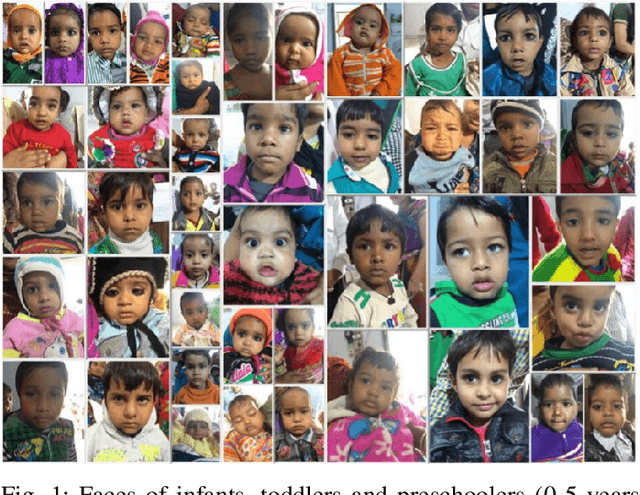
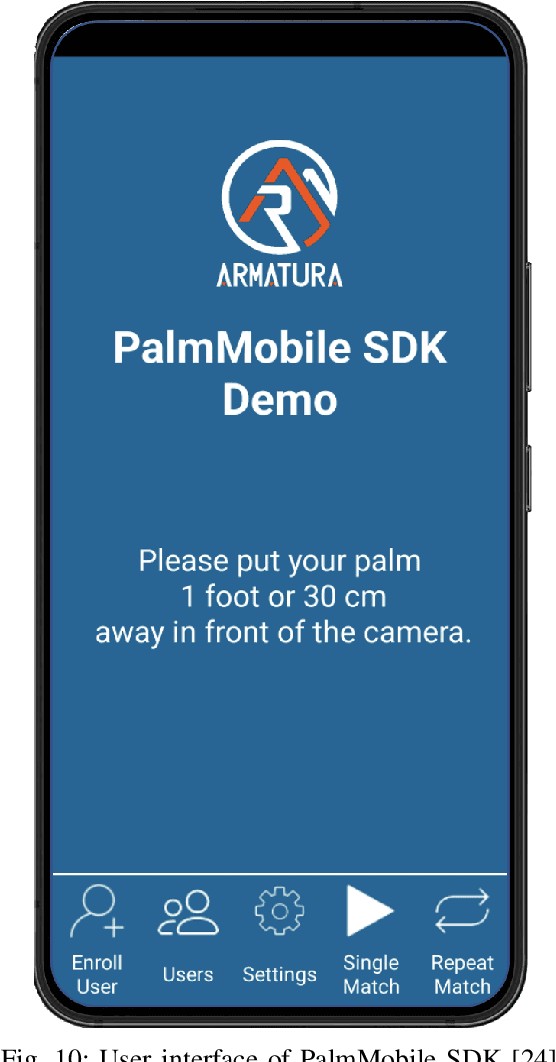
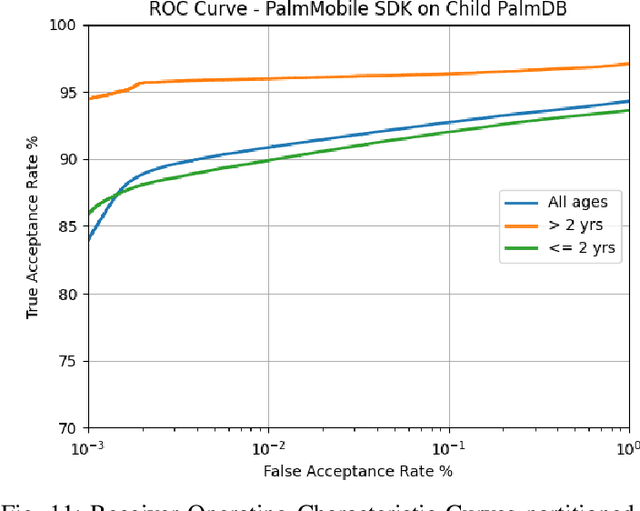
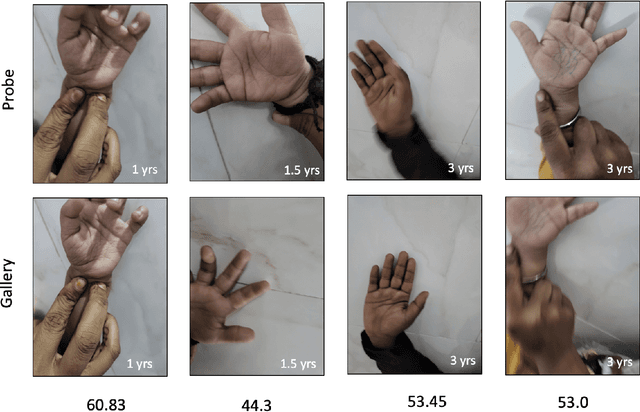
Abstract:Developing and least developed countries face the dire challenge of ensuring that each child in their country receives required doses of vaccination, adequate nutrition and proper medication. International agencies such as UNICEF, WHO and WFP, among other organizations, strive to find innovative solutions to determine which child has received the benefits and which have not. Biometric recognition systems have been sought out to help solve this problem. To that end, this report establishes a baseline accuracy of a commercial contactless palmprint recognition system that may be deployed for recognizing children in the age group of one to five years old. On a database of contactless palmprint images of one thousand unique palms from 500 children, we establish SOTA authentication accuracy of 90.85% @ FAR of 0.01%, rank-1 identification accuracy of 99.0% (closed set), and FPIR=0.01 @ FNIR=0.3 for open-set identification using PalmMobile SDK from Armatura.
Learning an Ensemble of Deep Fingerprint Representations
Sep 02, 2022



Abstract:Deep neural networks (DNNs) have shown incredible promise in learning fixed-length representations from fingerprints. Since the representation learning is often focused on capturing specific prior knowledge (e.g., minutiae), there is no universal representation that comprehensively encapsulates all the discriminatory information available in a fingerprint. While learning an ensemble of representations can mitigate this problem, two critical challenges need to be addressed: (i) How to extract multiple diverse representations from the same fingerprint image? and (ii) How to optimally exploit these representations during the matching process? In this work, we train multiple instances of DeepPrint (a state-of-the-art DNN-based fingerprint encoder) on different transformations of the input image to generate an ensemble of fingerprint embeddings. We also propose a feature fusion technique that distills these multiple representations into a single embedding, which faithfully captures the diversity present in the ensemble without increasing the computational complexity. The proposed approach has been comprehensively evaluated on five databases containing rolled, plain, and latent fingerprints (NIST SD4, NIST SD14, NIST SD27, NIST SD302, and FVC2004 DB2A) and statistically significant improvements in accuracy have been consistently demonstrated across a range of verification as well as closed- and open-set identification settings. The proposed approach serves as a wrapper capable of improving the accuracy of any DNN-based recognition system.
On Demographic Bias in Fingerprint Recognition
May 19, 2022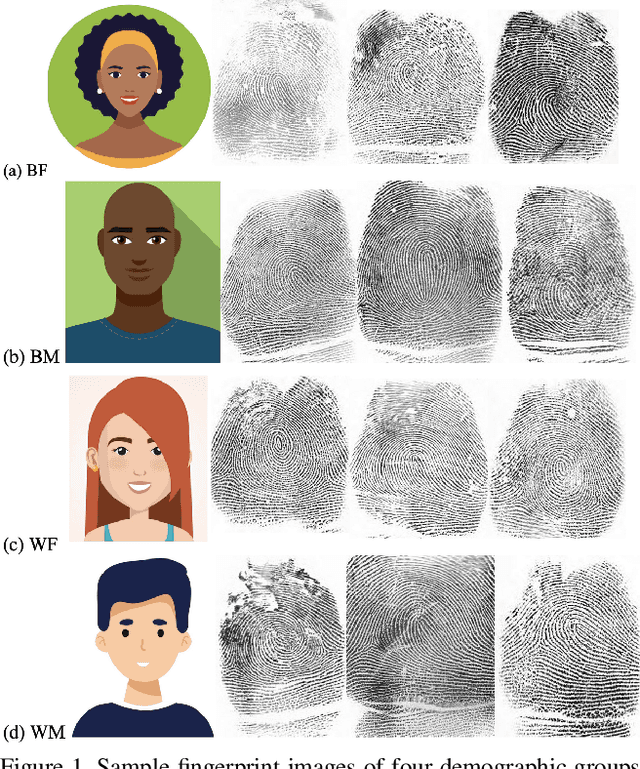

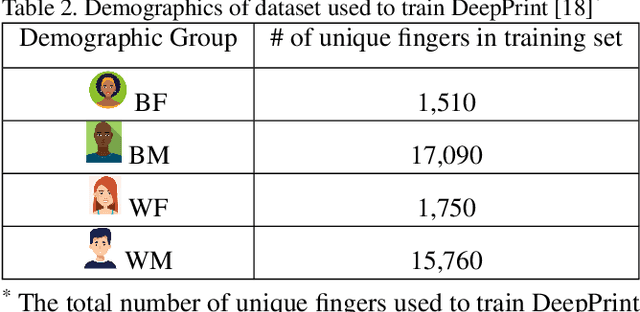
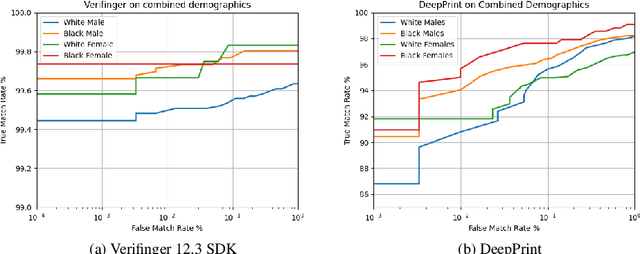
Abstract:Fingerprint recognition systems have been deployed globally in numerous applications including personal devices, forensics, law enforcement, banking, and national identity systems. For these systems to be socially acceptable and trustworthy, it is critical that they perform equally well across different demographic groups. In this work, we propose a formal statistical framework to test for the existence of bias (demographic differentials) in fingerprint recognition across four major demographic groups (white male, white female, black male, and black female) for two state-of-the-art (SOTA) fingerprint matchers operating in verification and identification modes. Experiments on two different fingerprint databases (with 15,468 and 1,014 subjects) show that demographic differentials in SOTA fingerprint recognition systems decrease as the matcher accuracy increases and any small bias that may be evident is likely due to certain outlier, low-quality fingerprint images.
 Add to Chrome
Add to Chrome Add to Firefox
Add to Firefox Add to Edge
Add to Edge